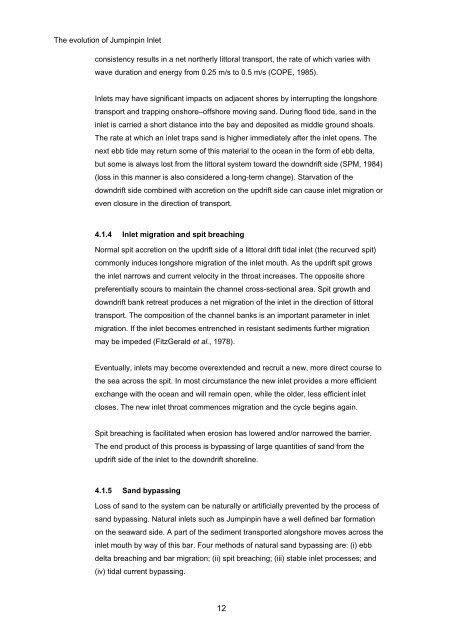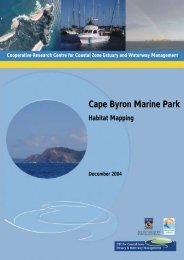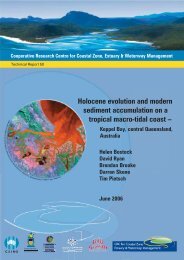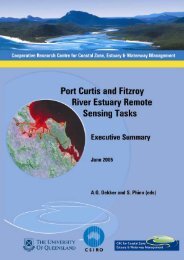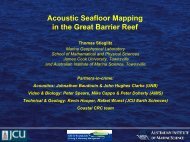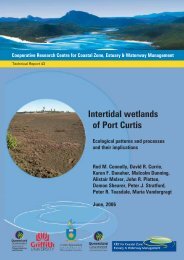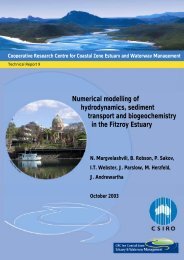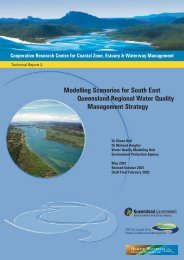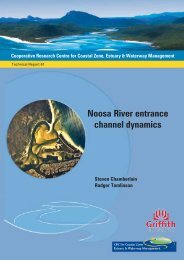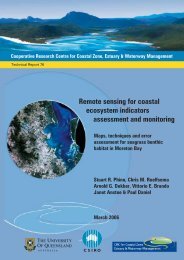The evolution of Jumpinpin Inlet - OzCoasts
The evolution of Jumpinpin Inlet - OzCoasts
The evolution of Jumpinpin Inlet - OzCoasts
You also want an ePaper? Increase the reach of your titles
YUMPU automatically turns print PDFs into web optimized ePapers that Google loves.
<strong>The</strong> <strong>evolution</strong> <strong>of</strong> <strong>Jumpinpin</strong> <strong>Inlet</strong><br />
consistency results in a net northerly littoral transport, the rate <strong>of</strong> which varies with<br />
wave duration and energy from 0.25 m/s to 0.5 m/s (COPE, 1985).<br />
<strong>Inlet</strong>s may have significant impacts on adjacent shores by interrupting the longshore<br />
transport and trapping onshore–<strong>of</strong>fshore moving sand. During flood tide, sand in the<br />
inlet is carried a short distance into the bay and deposited as middle ground shoals.<br />
<strong>The</strong> rate at which an inlet traps sand is higher immediately after the inlet opens. <strong>The</strong><br />
next ebb tide may return some <strong>of</strong> this material to the ocean in the form <strong>of</strong> ebb delta,<br />
but some is always lost from the littoral system toward the downdrift side (SPM, 1984)<br />
(loss in this manner is also considered a long-term change). Starvation <strong>of</strong> the<br />
downdrift side combined with accretion on the updrift side can cause inlet migration or<br />
even closure in the direction <strong>of</strong> transport.<br />
4.1.4 <strong>Inlet</strong> migration and spit breaching<br />
Normal spit accretion on the updrift side <strong>of</strong> a littoral drift tidal inlet (the recurved spit)<br />
commonly induces longshore migration <strong>of</strong> the inlet mouth. As the updrift spit grows<br />
the inlet narrows and current velocity in the throat increases. <strong>The</strong> opposite shore<br />
preferentially scours to maintain the channel cross-sectional area. Spit growth and<br />
downdrift bank retreat produces a net migration <strong>of</strong> the inlet in the direction <strong>of</strong> littoral<br />
transport. <strong>The</strong> composition <strong>of</strong> the channel banks is an important parameter in inlet<br />
migration. If the inlet becomes entrenched in resistant sediments further migration<br />
may be impeded (FitzGerald et al., 1978).<br />
Eventually, inlets may become overextended and recruit a new, more direct course to<br />
the sea across the spit. In most circumstance the new inlet provides a more efficient<br />
exchange with the ocean and will remain open, while the older, less efficient inlet<br />
closes. <strong>The</strong> new inlet throat commences migration and the cycle begins again.<br />
Spit breaching is facilitated when erosion has lowered and/or narrowed the barrier.<br />
<strong>The</strong> end product <strong>of</strong> this process is bypassing <strong>of</strong> large quantities <strong>of</strong> sand from the<br />
updrift side <strong>of</strong> the inlet to the downdrift shoreline.<br />
4.1.5 Sand bypassing<br />
Loss <strong>of</strong> sand to the system can be naturally or artificially prevented by the process <strong>of</strong><br />
sand bypassing. Natural inlets such as <strong>Jumpinpin</strong> have a well defined bar formation<br />
on the seaward side. A part <strong>of</strong> the sediment transported alongshore moves across the<br />
inlet mouth by way <strong>of</strong> this bar. Four methods <strong>of</strong> natural sand bypassing are: (i) ebb<br />
delta breaching and bar migration; (ii) spit breaching; (iii) stable inlet processes; and<br />
(iv) tidal current bypassing.<br />
12


